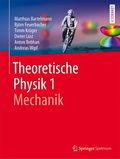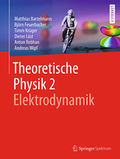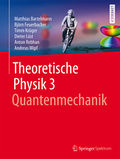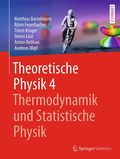
Homepage Anton Rebhan
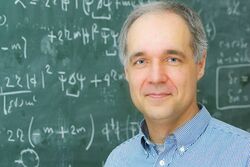
|
Senior Prof. DI Dr. Anton Rebhan anton.rebhan at tuwien dot ac dot at |
TEACHING
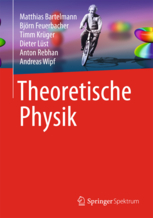 Ende November 2014 ist das Lehrbuch Theoretische Physik von M. Bartelmann, B. Feuerbacher, T. Krüger, D. Lüst, A. Rebhan & A. Wipf (hardcover, 1315 Seiten, durchgehend in Farbe) bei Springer Spektrum erschienen.
Ende November 2014 ist das Lehrbuch Theoretische Physik von M. Bartelmann, B. Feuerbacher, T. Krüger, D. Lüst, A. Rebhan & A. Wipf (hardcover, 1315 Seiten, durchgehend in Farbe) bei Springer Spektrum erschienen.
Dieses Buch ist die Grundlage für die von mir abgehaltenen Vorlesungen Elektrodynamik_I und Elektrodynamik II.
2018: Korrigierte und leicht erweiterte Neuauflage als vier separate Taschenbücher (1 2 3 4, zusammen 1404 Seiten). Im Netz der TU Wien über SpringerLink als e-books oder PDF files kostenlos verfügbar:
NB: Spezielle Relativitätstheorie ist Teil von Band 1, Kapitel 9 und 10
Auf dieser Seite zu finden:
- Unterlagen zu meinen Lehrveranstaltungen (Skripten, Folien etc.),
- aktuelle Informationen zu meinen Lehrveranstaltungen, wie sie auch über TUWIS an abonnierte Hörer verschickt werden.
(Wie die Vorlesungen selbst, in einem bunten Gemisch aus Englisch und Deutsch:)
WS 2025/26
Quantum Field Theory and Symmetries I
Lecture will be held in English
- Lecture schedule
- Wednesdays, 16:00-17:30, Seminar room (10th floor)
Literature:
- Mark Srednicki: Quantum Field Theory (free prepublication draft)
- Peskin/Schröder: Introduction to Quantum Field Theory
- Tony Zee: Quantum Field Theory in a Nutshell
The lecture will follow closely the text book by Srednicki, but with the same conventions used in Introduction to QED (which coincide with those of Peskin/Schröder)!
SS 2025
Introduction to Quantum Electrodynamics
- Schedule
- every Monday 11:15-12:45 seminar room DB10 (yellow)
- Literature
- Lecture notes (available in printed and bound form at the secretariat of the institute)
Quantum Field Theory and Symmetries II
Lecture will be held in English
- Lecture schedule
- Wednesdays, 16:00-17:30, Seminar room (10th floor)
WS 2024/25
Elektrodynamik II
diese Vorlesung hat eine eigene Webpage
Quantum Field Theory and Symmetries I
Lecture will be held in English
- Lecture schedule
- Wednesdays, 16:00-17:30, Seminar room (10th floor)
Arbeitsgemeinschaft für fundamentale Wechselwirkungen 1
PR (132.071)
- Vorbesprechung
- Donnerstag, 10. Oktober 2024, um 15:15, im Sem.R DB gelb 05 A
- Topic 2024/25
- Relativistic hydrodynamics
- vertagt auf Sommersemester!
SS 2024
Introduction to Quantum Electrodynamics
- Organizational meeting and start
- Monday March 4, 2024, 11:15 seminar room DB10 (yellow)
- Provisional schedule
- every Monday 11:15-12:45 seminar room DB10 (yellow)
- Literature
- Lecture notes (version 2016, will be updated)
Arbeitsgemeinschaft für fundamentale Wechselwirkungen 2
PR (132.074) w/ Kirill Boguslavski, Andreas Ipp
- Thema 2023/24
- Lattice QCD
see TISS/Tuwel
WS 2023/24
Introduction to Quantum Field Theory I
- Termin
- every Wednesday 16:00-17:30 seminar room DB10 (yellow)
- exceptions:
- Monday Oct 16 in place of Wednesday Oct 18
- Monday Oct 23 in place of Wednesday Oct 25
- Monday Dec 4 in place of Wednesday Dec 6
Voluntary exercises: see TUWEL course
Literatur:
- Mark Srednicki: Quantum Field Theory (free prepublication draft)
Arbeitsgemeinschaft für fundamentale Wechselwirkungen 1
PR (132.071) w/ Kirill Boguslavski, Andreas Ipp
- Thema 2023/24
- Lattice QCD
see TISS/Tuwel
SS 2023
Elektrodynamik I
diese Vorlesung hat eine eigene Webpage
Quantenfeldtheorie und Symmetrien II
VO (136.041), wird (sofern nicht einstimming Deutsch bevorzugt wird) in Englisch gehalten
Diese Vorlesung ist Teil 4 eines im 2-Jahreszyklus gehaltenen 4-semestrigen QFT-Kurses. Die Vorlesungen 'QFTI' und 'QFTII' werden das nächste Mal im Studienjahr 2021/22 angeboten. Um in 'QFT&Symm.' einzusteigen, reicht es aber z.B. auch, die Vorlesung 'Introduction to QED' gehört zu haben.
- Termin
- mittwochs 16:00-18:00
- Topic
- chiral gauge theories and anomalies, confinement in nonabelian gauge theories, chiral symmetry breaking and chiral Lagrangians, ...
- Prerequisites
- QFT+S1 und Introduction to QED oder Introduction to QFT I
Empfohlene Literatur:
- Mark Srednicki: Quantum Field Theory (free prepublication draft)
- Peskin/Schröder: Introduction to Quantum Field Theory
- Pokorski: Gauge Field Theories
- Tony Zee: Quantum Field Theory in a Nutshell
Arbeitsgemeinschaft für fundamentale Wechselwirkungen 2
PR (132.074)
- Thema 2020/21
- Gauge/gravity duality
see TISS/Tuwel
WS 2022/23
Quantenfeldtheorie und Symmetrien I
VO (136.014), wird (sofern nicht einstimming Deutsch bevorzugt wird) in Englisch gehalten
Diese Vorlesung ist Teil 3 eines im 2-Jahreszyklus gehaltenen 4-semestrigen QFT-Kurses. Die Vorlesungen 'QFTI' und 'QFTII' werden das nächste Mal im Studienjahr 2021/22 angeboten. Um in 'QFT&Symm.' einzusteigen, reicht es aber z.B. auch, die Vorlesung 'Introduction to QED' gehört zu haben.
- Termin
- mittwochs 16:00-18:00 SEM136
- Topic
- Introduction to non-Abelian gauge theories
- Prerequisites
- Introduction to QED oder Introduction to QFT I
Empfohlene Literatur:
- Mark Srednicki: Quantum Field Theory (free prepublication draft)
- Peskin/Schröder: Introduction to Quantum Field Theory
- Pokorski: Gauge Field Theories
- Tony Zee: Quantum Field Theory in a Nutshell
Arbeitsgemeinschaft für fundamentale Wechselwirkungen 1
PR (132.071)
- Thema 2020/21
- String Theory
see TISS/Tuwel
SS 2022
Quantenfeldtheorie
Introduction to quantum field theory II (VU together with Florian Hechenberger)
- Organisational meeting and start of part II: Thursday March 3, 2022, 10:15 via zoom (link on TUWEL)
WS 2021/22
Quantenfeldtheorie
Introduction to quantum field theory I (VU together with Florian Hechenberger) and Quantum field theory and symmetries I (zoom lectures) will be held in parallel.
- Organizational meeting for both: October 7, 2021, 11:00 on-line: via zoom
Arbeitsgemeinschaft für fundamentale Wechselwirkungen 1
- Topic 2021/22: Infrared Structure of Gravity and Gauge Theory
- Lecture notes: https://arxiv.org/abs/1703.05448
- Organisational meeting: Thursday, October 7, 2021, 14:15 on-line via zoom
SS 2021
Quantenfeldtheorie und Symmetrien II
VO (136.041), wird (sofern nicht einstimming Deutsch bevorzugt wird) in Englisch gehalten
Diese Vorlesung ist Teil 4 eines im 2-Jahreszyklus gehaltenen 4-semestrigen QFT-Kurses. Die Vorlesungen 'QFTI' und 'QFTII' werden das nächste Mal im Studienjahr 2021/22 angeboten. Um in 'QFT&Symm.' einzusteigen, reicht es aber z.B. auch, die Vorlesung 'Introduction to QED' gehört zu haben.
- Termin
- jeden Dienstag 9:15-10:45 via zoom (in TUWEL)
- Topic
- Spinors (in arbitrary dimensions), chiral gauge theories and anomalies, confinement in nonabelian gauge theories, chiral symmetry breaking and chiral Lagrangians, ...
- Prerequisites
- QFT+S1 und Introduction to QED oder Introduction to QFT I
Empfohlene Literatur:
- Mark Srednicki: Quantum Field Theory (free prepublication draft)
- Adapted lecture notes on Supersymmetry by Max Kreuzer (chapter 1 on spinors)
- Peskin/Schröder: Introduction to Quantum Field Theory
- Pokorski: Gauge Field Theories
- Tony Zee: Quantum Field Theory in a Nutshell
Arbeitsgemeinschaft für fundamentale Wechselwirkungen 2
PR (132.074) w/ Kirill Boguslavski, Andreas Ipp
- Thema 2020/21
- Quantum Fields on a Lattice
see TISS/Tuwel
WS 2020/21
Quantenfeldtheorie und Symmetrien I
VO (136.014), wird (sofern nicht einstimming Deutsch bevorzugt wird) in Englisch gehalten
Diese Vorlesung ist Teil 3 eines im 2-Jahreszyklus gehaltenen 4-semestrigen QFT-Kurses. Die Vorlesungen 'QFTI' und 'QFTII' werden das nächste Mal im Studienjahr 2021/22 angeboten. Um in 'QFT&Symm.' einzusteigen, reicht es aber z.B. auch, die Vorlesung 'Introduction to QED' gehört zu haben.
- Vorbesprechung
- Dienstag 6.10.2020 15:00, https://tuwien.zoom.us/j/94368838497?pwd=aWNsWVYzd2xZTC9XbkJMWk9VZHlkZz09
- Termin
- mittwochs 10:00-11:30 via zoom (in TUWEL)
- Topic
- Introduction to non-Abelian gauge theories
- Prerequisites
- Introduction to QED oder Introduction to QFT I
Empfohlene Literatur:
- Mark Srednicki: Quantum Field Theory (free prepublication draft)
- Peskin/Schröder: Introduction to Quantum Field Theory
- Pokorski: Gauge Field Theories
- Tony Zee: Quantum Field Theory in a Nutshell
Arbeitsgemeinschaft für fundamentale Wechselwirkungen 1
PR (132.071) w/ Kirill Boguslavski, Andreas Ipp
- Thema 2020/21
- Quantum Fields on a Lattice
see TISS/Tuwel
SS 2020
Einführung in die Quantenfeldtheorie/Introduction to QFT II
Lecture will be held in English
- Organizational meeting
- Wednesday March 4, 16:00, Seminar room (10th floor)
- Begin
- Wednesday March 11, 16:00, Seminar room (10th floor)
- Date and Time
- Wednesdays, 16:00-17:30, Seminar room (10th floor)
Literature:
- Mark Srednicki: Quantum Field Theory (free prepublication draft)
- Peskin/Schröder: Introduction to Quantum Field Theory
- Tony Zee: Quantum Field Theory in a Nutshell
- Cvitanovic: Field theory
- Adapted lecture notes on Supersymmetry by Max Kreuzer (chapter 1 on spinors used in QFT II, with adapted conventions and some corrections)
The lecture will follow closely the text book by Srednicki, but with the same conventions used in Introduction to QED (which coincide with those of Peskin/Schröder)!
Arbeitsgemeinschaft für fundamentale Wechselwirkungen 2
PR (132.074)
- Termin
- Donnerstags 14:15 Uhr, SEM 136, FH 10.OG, Vorbesprechung 5.3.2020
- Topic 2019/20
- Machine learning for physicists
WS 2019/20
Elektrodynamik II
diese Vorlesung hat eine eigene Webpage
Einführung in die Quantenfeldtheorie/Introduction to QFT I
Lecture will be held in English
- Start
Monday, October 7, 10:15, FH HS 3Wednesday, October 2, 16:15, FH HS 2
- Lecture schedule
- No lecture October 9!
- Wednesday October 16 and 23: FH HS 2, 16:15-17:45
- then every Tuesday, October 29 - January 28,
FH HS 6, 16:15-17:45, moved to: Seminar room 107/1, Wiedner Hauptstr. 7, 1. Stock (Goldenes Lamm)
Literature:
- Mark Srednicki: Quantum Field Theory (free prepublication draft)
- Peskin/Schröder: Introduction to Quantum Field Theory
- Tony Zee: Quantum Field Theory in a Nutshell
- Cvitanovic: Field theory
The lecture will follow closely the text book by Srednicki, but with the same conventions used in Introduction to QED (which coincide with those of Peskin/Schröder)!
Material covered in QFT I: ch. 1-14
Arbeitsgemeinschaft für fundamentale Wechselwirkungen 1
PR (132.071)
- Termin
- Donnerstag 14:15 Uhr, SEM 136, FH 10.OG, Vorbesprechung 3. Oktober
- Topic 2019/20
- Machine learning for physicists
SS 2019
Arbeitsgemeinschaft für fundamentale Wechselwirkungen 2
PR (132.074) - w/ Timm Wrase
Topic 2018/19: Introduction to supersymmetry (and supergravity)
- Literatur
- D. Freedman and A. Van Proeyen: Supergravity
Professor Antoine Van Proeyen (U. Leuven, Belgium) will be at the ESI for one month during March for a course (with ECTS points) on 4d, N=1 supergravity. In the winter term our Arbeitsgemeinschaft served as a preparation for this. In April the Arbeitsgemeinschaft continues with studying subsequent topics in the book of Freedman and Van Proeyen, in particular N=2 supergravity.
Hard thermal loops for (non-)equilibrium quark-gluon plasma
On-line course (video lectures and slides) at the International Centre for Theoretical Physics at Bangalore, India, 1-17 April 2019:
THE MYRIAD COLORFUL WAYS OF UNDERSTANDING EXTREME QCD MATTER
WS 2018/19
Quantum Field Theory: My usual 4-semester series of quantum field theory courses will be resumed in the academic year 2019/20. This winter term I shall offer instead an introduction to quantum field theory at finite temperature and density:
Thermal Quantum Field Theory
- Termin
- Thursdays 10:15-11:45, Seminar room FH 10th floor (Sem.R. DB gelb 10)
- Thursday, November 29: 10:30-12:00
- Literatur
- Lecture notes of Andreas Schmitt from W2013/14 continuously updated during the course
- Lecture notes by M. Laine and A. Vuorinen: Basics of Thermal Field Theory
Arbeitsgemeinschaft für fundamentale Wechselwirkungen 1
PR (132.071) - w/ Timm Wrase
- Vorbesprechung
- Donnerstag 4.10.2018, 14:15 Uhr, SEM 136, FH 10.OG
Topic 2018/19: Introduction to supersymmetry (and supergravity)
- Literatur
- D. Freedman and A. Van Proeyen: Supergravity
Professor Antoine Van Proeyen (U. Leuven, Belgium) will be at the ESI for one month next spring semester and he will offer a course (with ECTS points) on 4d, N=1 supergravity. Our Arbeitsgemeinschaft this semester serves as a preparation for this, starting with a review of relativistic scalar, spinor, and gauge field theory in flat Minkowski space.
Previous semesters
Below you can find information on and material for lectures of past semesters. Some material pertaining to much older lectures can still be found at my (now obsoleted) old official home page.
Antrittsvorlesung
Öffentliche Antrittsvorlesung "Quark-Gluon-Plasmaphysik": Mo., 2. Juni 2008, 17:00 Freihaus HS 5 (2. Stock, grüner Bereich)
Elektrodynamik und Relativitätstheorie 4h VO (SS 2007)
Vorlesungsfolien (kapitelweise als PDF-files)
Vorlesungsskriptum
- 7. Aufl. erhältlich im Sekretariat E136 (10.OG) zum Preis von 10 €; oder on-line als PDF files
Nicht vorgetragen und daher auch nicht Prüfungsstoff: Kap. IV.2.C, VI.2.D, VI.4, X.1.A, XIII, XIV.4, XVI [NB: (XVI.29) schon in Kap. XI]
Ergänzende Literaturempfehlungen etc.
- H. Römer, M. Forger: Elementare Feldtheorie : Elektrodynamik, Hydrodynamik, spezielle Relativitätstheorie (VCH), on-line als PDF file am Freiburger Dokumentenserver abrufbar
- zur Auffrischung und Vertiefung der Methodenkenntnisse: K. Jähnich: Analysis für Physiker und Ingenieure (Springer)
- http://www.tempolimit-lichtgeschwindigkeit.de : Nette Homepage mit Visualisierungen zur Relativitätstheorie
Prüfungen
- Modus und Termine: unter Exams#Prof._A._Rebhan
Thermische Quantenfeldtheorie (SS 2007)
Geänderter Vorlesungstermin: Mittwoch SEM 136 (10.OG) 16:00-17:30
Ausnahme: Die Vorlesung vom Mi., den 20.6. wird auf Di., den 19.6. vorverlegt.
(Bits of) Lecture Notes (postscript files):
- Orders of magnitude in ultrarelativistic plasma physics (28K)
- Basic formulae of statistical quantum mechanics (28 K)
- Elementary modelling of the QCD phase transition (1.7M)
- Many-particle propagators (96K)
- Many-particle propagators for a scalar field theory (34K)
- Perturbation theory at zero vs. nonzero temperature (36K)
- Imaginary-time (Matsubara) formalism (34K)
- Real-time (Keldysh) formalism (38K)
- Decay and creation rates (21K)
- Gauge theories at finite T (50K)
- Linear response in gauge theories at finite T (53K)
- Fermionic quasi-particles (42K)
- Hard-thermal-loop resummation (26K)
- Symmetry restoration in spontaneously broken theories (29K)
(More advanced) Lecture Notes from courses I gave at International Summer Schools:
- Schladming 2001: Thermal Gauge Field Theories (47 Seiten)
- Cargèse 2001: Hard thermal loops and QCD thermodynamics (26 Seiten)
September-October 2005 I held a series of lectures as "James H. Simons lecturer" at the YITP, State Univ. of New York at Stony Brook on Thermal Field Theory. Scanned lecture notes are available here.
RESEARCH
Research positions held
- 1986-05-01 - 1989-12-31 ITP, TU Wien (Universitätsassistent)
- 1990-01-01 - 1991-12-31 Fellowship at the Theory Divison, CERN, Geneva (CH)
- 1992-01-01 - 1992-08-31 Scientific Associate at the Theory Divison of CERN
- 1992-03-01 - 1992-07-31 Boursier du Ministère des Affaires Etrangères (France) at Laboratoire de Physique Théorique LAPP, Annecy-le-Vieux (F)
- 1992-09-01 - 1993-03-31 ITP, TU Wien (Universitätsdozent)
- 1993-04-01 - 1993-10-31 C4-Lehrstuhlvertretung (Prof. F. Karsch), Fakultät für Physik, Universität Bielefeld (D)
- 1993-11-01 - 1995-10-31 Senior Research Associate at DESY, Gruppe Theorie, Hamburg (D)
- 1995-11-01 - 2008-02-29 Associate Professor, ITP, TU Wien (Außerordentlicher Universitätsprofessor)
- since 2008-03-01 Full Professor, ITP, TU Wien
Research Interests and Projects
My research interests comprise theoretical particle physics and its ramifications, in particular quantum field theory, gauge theories, supersymmetry, thermal field theory, and cosmology.
My main current research activities involve
- Quantum field theory at finite temperature and density
- which is the theoretical tool to analytically study quantum matter under extreme conditions, e.g. ultrarelativistic temperatures and densities that existed in the early universe in the first second after the Big Bang. Of particular interest is the high-temperature regime of quantum chromodynamics which is supposed to describe the quark-gluon plasma that filled the universe during the first 10 μsec's. This form of matter is now believed to be produced fleetingly in "Little Bangs" in ultrarelativistic heavy-ion collider experiments such as RHIC and also expected to exist in the interior of (some) neutron stars.
- Nonabelian plasma instabilities
- An open problem in quark-gluon plasma physics is to understand the very fast apparent thermalization observed at RHIC and also the extremely low viscosity of the quark-gluon plasma. For both phenomena it has been suggested that nonabelian plasma instabilities may play a crucial role. Together with my former student Paul Romatschke (now at the University of Washington, Seattle) and former post-doc Mike Strickland (now at FIAS, Frankfurt) we were the first group to carry out numerical simulations of nonabelian plasma instabilities in Yang-Mills theories, which are now being studied by several groups in the US and Europe. Recently we have published the first numerical study of nonabelian plasma instabilities in an anisotropically expanding system.
- Quantum theory of (supersymmetric) solitons
- In recent years, major progress in the understanding of non-perturbative aspects of (supersymmetric) field (and string) theories has been achieved by exploiting dualities in which quantized (supersymmetric) solitons play a central role. Initially it was thought that supersymmetric solitons saturating the so-called BPS bound are protected from quantum corrections, but in collaboration with Peter van Nieuwenhuizen from the State Univ. of New York at Stony Brook, we have found, and are still working out, a number of subtleties and nontrivial results, in particular for 1+1-dimensional supersymmetric kinks (domain walls) and 3+1-dimensional monopoles. Other objects of interest are supersymmetric "confined monopoles" which permit analytical studies with relevance to the outstanding confinement problem of nonabelian gauge theories.
Publications
Since 1984 (the start of my doctoral studies), I have written or co-authored over 150 scientific publications, most of which are available on-line (freely accessible as arXiv.org e-prints) through:
- Hyperlinked list of my publications (INSPIRE-HEP database)
- My TOPCITE publications (papers with more than 50 citations)
- INSPIRE-HEP citation summary
- Google Scholar Citations
- Thomson Reuters ResearcherID: H-2493-2012
LINKS
Public outreach
TU News involving members of my group:
- Workshop über Quark-Gluon-Plasmaphysik (2005-08-09)
- Antrittsvorlesung von Prof. Anton Rebhan (2008-05-28)
- ProfessorInnen im Porträt "Anton Rebhan – Professor für Theoretische Physik" (2008-07-14)
- Supercomputer-Rekordjagd an Wiener Universitäten (2010-04-19, Presseaussendung 21/2010)
- Heißer Sommer für das Quark-Gluon-Plasma in Wien (2010-08-16, Presseaussendung 51/2010)
- Der kürzeste Film der Welt (2011-09-27, Presseaussendung 65/2011)
- Die flüssigste Flüssigkeit des Universums (2012-01-18, Presseaussendung 6/2012)
- zugehörige Physical Review Letters Publication
- Physics Synopsis Out of bounds
- Möchten Sie Ihr schwarzes Loch mit Milch? (2013-03-13)
- Ein Teilchen aus reiner Kernkraft (2015-10-12)
- Myon-Magnetismus: Hinweise auf „neue Physik“? (2021-04-01)
- Triumph für das Standardmodell der Physik (2025-06-04)
- Wenn Licht mit Licht zusammenstößt (2025-07-28)
For more information and news on nuclear and particle physics written for the public visit:
This contains the public outreach web pages of the Fachausschuss für Kern- und Teilchenphysik (FAKT) of the ÖPG (Austrian Physical Society), which I was involved in creating and where I am a regular author.
It also hosted the coordinated efforts of Austrian scientists to appeal for a reversal of the recent decision by the ministry of science to cancel Austria's membership of CERN
My collaborators
List of collaborators with joint scientific publications and links to their present home institutions/home pages (where available)
- Maximilian Attems (joint papers) TU Wien → Frankfurt → Barcelona → Santiago de Compostela
- Rolf Baier (joint papers) Univ. Bielefeld
- Lorenzo Bartolini (joint papers) Univ. Florenz → Henan U. → TU Wien
- Carl M. Bender (joint papers) Washington Univ., St. Louis (US)
- Jean-Paul Blaizot (joint papers) Service de Physique Théorique, CEA Saclay (F)
- Dietrich Bödeker (joint papers) Univ. Bielefeld (D)
- Frederic Brünner (joint papers) TU Wien
- Luigi Cappiello (joint papers) Univ. Neapel
- Margaret E. Carrington (joint papers) Brandon University, Manitoba (Canada)
- Rosanne Di Stefano (joint papers) YITP, State Univ. of New York at Stony Brook (US)
- Ian Drummond (joint papers) DAMTP, University of Cambridge (UK)
- Christian Ecker (joint papers) TU Wien
- Fritjof Flechsig (joint papers) Univ. Hannover (D)
- Kazuo Fujikawa (joint papers) Univ. of Tokyo (Japan)
- Peter Gaigg (joint papers) TU Wien (now: Siemens Austria)
- Andreas Gerhold (joint papers) TU Wien → Univ. of North Carolina, Raleigh (US)
- Alfred S. Goldhaber (joint papers) YITP, State Univ. of New York at Stony Brook (US)
- Sven Bjarke Gudnason (joint papers) Henan Univ. (China)
- Antti Gynther (joint papers) Univ. Helsinki (Finland) (HP) → Brandon University, Canada → TU Wien
- Florian Hechenberger (joint papers) TU Wien → Stony Brook University, New York
- Ron Horgan (joint papers) DAMTP, University of Cambridge (UK)
- Edmond Iancu (joint papers) Service de Physique Théorique, CEA Saclay (F)
- Andreas Ipp (joint papers) TU Wien (HP) → ECT*, Trento (I) → MPI für Kernphysik, Heidelberg (D)
- Keijo Kajantie (joint papers) University of Helsinki (Finland)
- Robert Knienider (joing papers) TU Wien
- Randy Kobes (joint papers) University of Winnipeg (Canada)
- Ulrike Kraemmer (joint papers) TU Wien
- Thomas Kreuzberger (joint papers) TU Wien
- Maximilian Kreuzer (joint papers) Staff, TU Wien
- Wolfgang Kummer (joint papers) Staff, TU Wien
- Gabor Kunstatter (joint papers) University of Winnipeg (Canada)
- Aleksi Kurkela (joint papers) CERN
- Peter Landshoff (joint papers) DAMTP, University of Cambridge (UK)
- Karl Landsteiner (joint papers) Universidad Autónoma de Madrid (HP)
- Piotr Lebiedowicz (joint papers) INP Cracow (Poland)
- Martin Leblanc (joint papers) University of Waterloo (Canada)
- Josef Leutgeb (joint papers) TU Wien
- Dietrich Liko (joint papers) TU Wien → HEPHY, Wien
- Jonas Mager (joint papers) TU Wien
- Christoph Mayrhofer (joint papers) Munich
- Gerry McKeon (joint papers) University of Western Ontario (Canada)
- Toshali Mitra (joint papers) IMSc Chennai (India)
- Sukrut Mondkar (joint papers) IIT Madras (India)
- Guy D. Moore (joint papers) McGill University, Montreal (Canada)
- Stanisław Mrówczyński (joint papers) Sołtan Inst., Warsaw (PL)
- Ayan Mukhopadhyay (joint papers) TU Wien → IIT Madras (India) → Pont. Univ. Catolica Valparaiso (Chile)
- Herbert Nachbagauer (joint papers) TU Wien → LAPP, Annecy-le-Vieux (F) → Univ. Heidelberg (D)
- Otto Nachtmann (joint papers) Univ. Heidelberg (D)
- Horatiu Nastase (joint papers) YITP, State Univ. of New York at Stony Brook (US) → Brown Univ. (US) → Tokyo Institute of Technology
- Denis Parganlija (joint papers) TU Wien
- Francisco Peña-Benitez (joint papers) Universidad Autónoma de Madrid
- Olivier Piguet (joint papers) Univ. Geneva (CH) → Espirito Santo Univ., Vitoria (Brazil)
- Florian Preis (joint papers) TU Wien
- Urko Reinosa (joint papers) Ecole Polytechnique, Palaiseau (F) → TU Wien → Univ. Heidelberg (D)
- Paul Romatschke (joint papers) U.o.Colorado
- Andreas Schmitt (joint papers) Univ. Frankfurt → MIT → Washington U. St.Louis → TU Wien → U. Southampton
- Robert Schöfbeck (joint papers) TU Wien → HEPHY, Wien
- Hermann Schulz (joint papers) Univ. Hannover (D)
- Dominik J. Schwarz (joint papers) TU Wien → Univ. Bielefeld (D)
- Manfred Schweda (joint papers) Staff, TU Wien
- Tom Sherry (joint papers) University Coll., Galway (Ireland)
- Alexander Soloviev (joint papers) TU Wien → Univ. Ljubljana (Slovenia)
- Michael Stadlbauer (joint papers) TU Wien → TU Munich
- Dominik Steineder (joint papers) TU Wien
- Misha Stephanov (joint papers) YITP, State Univ. of New York at Stony Brook (US) → Univ. of Chicago (US)
- Stefan Stricker (joint papers) TU Wien
- Mike Strickland (joint papers) Duke Univ. (US) → TU Wien → U. Helsinki → FIAS Frankfurt (D) → Gettysburg College → Kent U.
- Antoni Szczurek (joint papers) INP Cracow (Poland)
- Günther Turk (joint papers) TU Wien → U. Cambridge
- Peter van Nieuwenhuizen (joint papers) YITP, State Univ. of New York at Stony Brook (US)
- Dmitri V. Vassilevich (joint papers) Univ. Leipzig (D) → Univ. Sao Paolo, Brazil
- Aleksi Vuorinen (joint papers) Univ. Helsinki (Finland) (HP) → Washington University, Seattle (US) → TU Wien → CERN → Univ. Bielefeld (D) → Helsinki
- Robert Wimmer (joint papers) TU Wien → Univ. Hannover → YITP, State Univ. of New York at Stony Brook (US) → ENS Lyon
- Gunter Wirthumer (joint papers) TU Wien (now: Alcatel)
- Matthias Wödlinger (joint papers) TU Wien
(Co-)organized Workshops and Conferences
Research workshops and conferences where I am/was organizer or on the advisory board:
- 5th International Workshop on Thermal Field Theories and Their Applications: Regensburg, August 10 - 14, 1998 (organizing committee)
- ESI Research Program on Quantization, Generalized BRS Cohomology, and Anomalies: Vienna, September - November 1998 (organizing committee)
- Strong and Electroweak matter '98: Copenhagen, December 2-5, 1998 (advisory board)
- Strong and Electroweak matter 2000: Marseilles, June 14-17, 2000 (advisory board)
- Strong and Electroweak matter 2002: Heidelberg, October 2-5, 2002 (advisory board)
- Strong and Electroweak matter 2004: Helsinki, June 16-19, 2004 (advisory board)
- Quark Matter 2005: Budapest, August 1-6, 2005 (regional advisory committee)
- Workshop on Quark-Gluon Plasma Thermalization, TU Vienna, August 10-12, 2005 (organizer)
- 2nd Vienna Central European Seminar on Particle Physics and Quantum Field Theory - Frontiers in Astroparticle Physics, Uni Wien, November 25-27, 2005 (advisory board)
- Strong and Electroweak matter 2006, Brookhaven National Laboratory, NY, May 10-13, 2006 (advisory board)
- INT Workshop on Nonequilibrium Quark-Gluon Plasma, University of Washington, Seattle, September 25-30, 2006 (organizing committee)
- Strong and Electroweak matter 2008: Amsterdam, 26-29 August 2008 (advisory board)
- http://www.physics.mcgill.ca/sewm2010/ Strong and Electroweak matter 2010]: McGill University, Montreal, June 29 - July 2, 2010(advisory board)
- Anti-de Sitter holography and the quark-gluon plasma: analytical and numerical aspects: Erwin-Schrödinger Institute, Vienna, August 2 - October 29, 2010 (organizer, with K. Landsteiner & S. Husa)
- EMMI-Workshop Hot Matter: Vienna, August 24 - 28, 2010 (organizer, with R. Baier, O. Kaczmarek & P. Romatschke)
- Memorial Conference for Maximilian Kreuzer: ESI, Vienna, June 25-28, 2011 (organizer, with L. Katzarkov, J. Knapp, E. Scheidegger)
- Strong and Electroweak matter 2012: Swansea, July 10-13, 2012
- Strong and Electroweak matter 2014: Lausanne, July 14-18, 2014
- Strong and Electroweak matter 2016: Stavanger, July 11-15, 2016
- Strong and Electroweak matter 2018: Barcelona, June 25-29, 2018
- Strong and Electroweak matter 2022: Paris, June 20-24, 2022
- Strong and Electroweak matter 2024: Frankfurt, August 25-30, 2024

